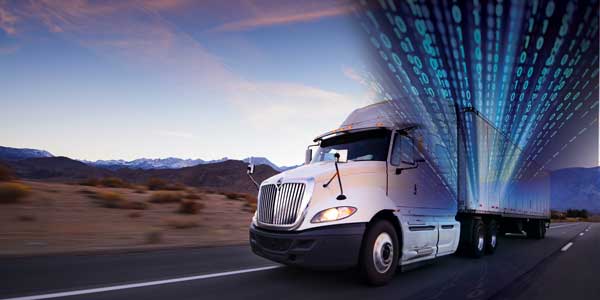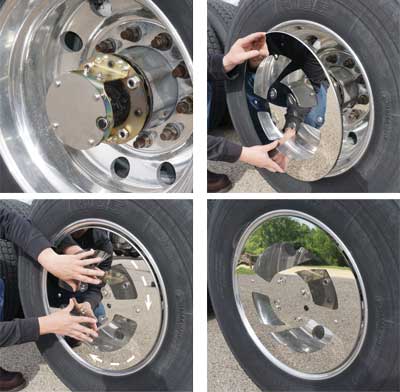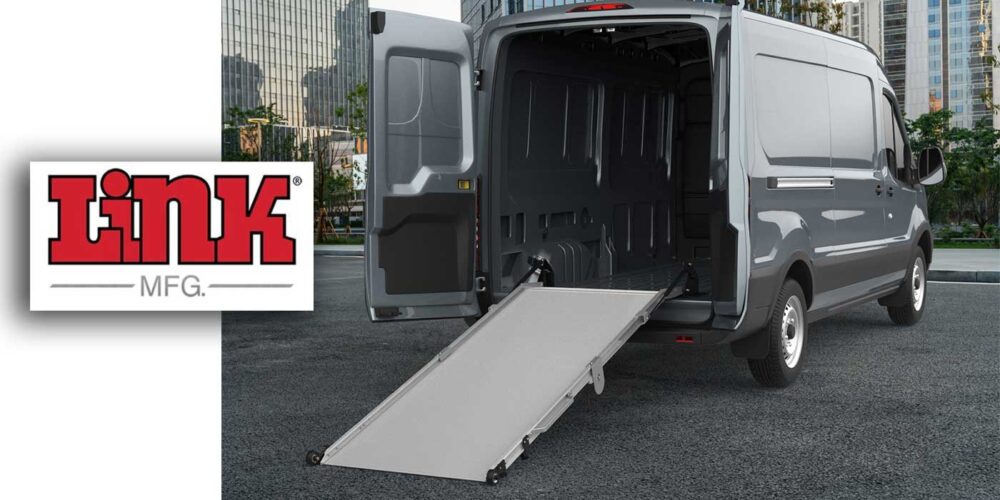There are two hot topics right now related to fuel efficiency and wheel ends. The first: Tire pressure monitoring systems (TPMS) have been given fuel economy coefficients in NHTSA’s and EPA’s Phase 2 of the Greenhouse Gas (GHG) regulations for commercial trucks and trailers. As you know, trailers covered by GHG Phase 2 will use fuel-efficient tires and automatic tire inflation systems and/or TPMS to meet the new fuel economy targets. It stands to reason that more and more fleets should be considering TPMS integrated with telematics (TPMS 2.0) to get the tire visibility they need, especially fleets that have tried ATIS but moved away from it for various reasons (yes, there are many who have done that). Since at the moment every fleet is looking at ELDs that are enabled by telematics, the leap to telematics combined with TPMS is not a long one.
The second issue is aerodynamic wheel covers. The ATA Technology & Maintenance Council (TMC) just balloted and passed RP 261: Considerations for Aerodynamic Wheel Covers, which describes the important operational, inspection and maintenance considerations associated with their use. Many fleets are looking at these devices to get another 1% to 2% savings in fuel economy, but before they do, they should know what to consider and what they may be getting themselves into.
Inspection is critical
So what are the important operational, inspection and maintenance considerations associated with the use of wheel covers that affect wheel end components? According to Dave Walters, manager of warranty and field service at Alcoa Wheel and chair of the task force that wrote RP 261, “Inspection is critical. Check the wheel/axle end components for service related issues, such as broken or missing wheel studs and nuts; leaking wheel seals; cracked wheels, loose cap-nuts. Maintenance considerations include whether the cover is connected correctly or if it’s rubbing on the wheel, and whether the brackets that mount the cover are in good condition. The operational issue is making sure the cover is in good condition and properly attached.”
Walters added that the CVSA inspectors won’t give the truck the sticker for future safety inspections unless the driver can remove the cover for the safety inspector.
“With the wheel covers installed, visual inspection of the wheel end’s overall condition is severely compromised,” warns Johnathon Capps, vice president of engineering for Webb Wheel. “For instance, the wheel covers prevent visual inspection of the wheel studs and nuts to review for signs of clamp load loss. They also prevent the visual inspection of the assembly component’s mating surfaces for any abnormalities such as cracks, deformation, heavy corrosion, lubrication leaks, etc.”
He adds that wheel covers can also reduce airflow through the wheel end, which can lead to increased component temperatures and a reduction in life, including the associated braking components.
“Webb has recently designed and launched several brake drums that improve the overall thermal management of a braking system with features that improve the rate of heat removal in an effort to extend component life,” Capps says.
“Aerodynamic wheel covers provide positive fuel economy benefits to owners and fleets—and the need to address maintenance considerations associated with them has been addressed in RP 261,” says Bryan Williams, ConMet’s director of product development—wheel ends. “The key considerations for the wheel end and its components are the ability to inspect the wheel end and the potential effect of wheel covers on operating temperatures in the wheel end. The drivers and technicians need to be able to quickly and easily inspect for fluid leaks, loose or missing fasteners, lubricant condition and signs of excessive heat during pre-trip and in-route inspections. These inspections would also apply to the potential risk of increased operating temperatures in the wheel end due to reduced air flow behind the wheel cover. Excessive operating temperatures can lead to lubricant degradation, seal leaks, and affect bearing performance.
“There should be no need for increased maintenance or service of wheel ends or their components associated with aerodynamic wheel covers,” Williams continues. “The standard pre-trip and in-route inspections, as well as inspections during any regularly scheduled maintenance are still recommended, although this may require the removal of the wheel cover to access the wheel end.
“Improved fuel economy for owners and fleets is key to their success and better use of aerodynamic features/components is an important aspect of realizing those gains,” he adds. “Understanding the potential effect of these features and realizing that inspections and well-maintained equipment are still the most important aspects of long-term optimal wheel end performance.”
TPMS and telematics
“Over the last 25 years, major carriers have moved to adopt telematics to help them improve productivity, fuel economy, maintenance and safety,” says Peggy Fisher, president of Tire Stamp. “Telematics has enabled them to make insightful decisions in real time to improve driver behavior which impacts safety, customer satisfaction and driver retention. By integrating electronic TPMS with telematics, the second generation of TPMS, TPMS 2.0, has been created.”
Fisher explains that TPMS 2.0 provides fleets with remote diagnostics for tires. Not only can alerts be sent to anyone with an internet connection, but useful reports and dashboards can be generated that provide fleet managers with the health of all the tires in the fleet, comparisons of the quality of tire maintenance at their various locations, and provide technicians with tire work orders and instructions for correcting them. Knowing and addressing problem tires before drivers take off can prevent 90% of enroute breakdowns, Fisher says.
“Operations can also be more efficient since some systems can predict when a tire problem will become serious and can advise how much time the tire has before service is mandatory,” she continues. “Also, since miles are recorded, some things like providing reminders for torque checks after a tire change and accumulating the number of miles tires are run underinflated or overheated, which used to be an impossibility, can now be done. The bottom line is, the tire visibility TPMS 2.0 provides presents a wealth of opportunities for fleets to improve tire maintenance, fuel economy, safety and tire performance, all with less labor.”
James Herman, director of fleet maintenance for Perdue Farms Inc., explains how TPMS data is collected, reviewed and used on the company’s fleet trucks: “One system is integrated into an on-board Omnitracs system. This has the advantage of eliminating one cell phone subscription and one additional website to monitor. The other system is stand-alone but does offer more complete information such as wheel end temperatures and adjusts PSI to ambient temperature.
“The benefits of combining systems to one platform makes it much easier to manage and lowers cost,” he adds. “Getting real-time information on a potential problem saves time and money. We have reduced blowouts and road calls, and do a better job of maintaining proper tire pressures, which helps tread life and fuel mileage. TPMS is a great tool to prevent and or minimize tire problems and cost—not only to know when a tire is losing air, but also to make adjustments for seasonal changes as well and maintaining proper pressures for better fuel mileages. Catching a tire that is losing air before it goes too far can also save casings. We know when a tire starts to lose air the same time as the driver. If they do not react, we will. Our tire costs are very competitive for the different applications that we use them for.”
Choosing wheel covers
According to Jan Polka, president of RealWheels Corp., when choosing aerodynamic wheel end covers, the main considerations are:
- Ease of installation and removal of both the cover bracket and aero cover;
- Overall ROI with consideration to the initial investment and life of cover;
- Option to view wheel and lug nuts through the aero cover;
- Ability to cover a range of wheel types (22.5- and 24.5-in. wheels, dual aluminum and steel wheels, wide base single wheels including zero offset, tractor and trailer wheels);
- Option to lock the aero wheel cover to avoid theft.
While the choice of aluminum or steel wheels is not an issue when installing most aero covers, consideration must be given to wide base single wheels, 24.5-in. wheels and trailer wheels, as not all aero covers will fit these.
“With aluminum wheels,” Polka adds, “it’s beneficial that wheel cover floats and does not make any contact with the wheel when installed. Wheels, aero covers and mounting hardware all need to be easily inspected, cleaned and maintained. To facilitate this, the aero cover should be easily removed and re-installed. In addition, mounting hardware should also install easily, ideally without removing any wheel nuts or bolts. The ability to remove the wheel from the axle, without removing the bracket, is also a plus.
“Every fleet has unique needs when it comes to aerodynamic wheel covers,” he continues. “RealWheels, the first in the industry to offer aero covers, has developed a full line to provide fleets with maximum choices, all based around our Twist & Lock Bracket. We give fleets the widest choice of materials (mirror stainless steel, clear polycarbonate and ABS). We also offer an aero cover that combines a lightweight mirror stainless cover with a high-impact, clear polycarbonate viewing window. Our clear style covers reduce wheel cover removal for basic inspections by as much as 50%.”














